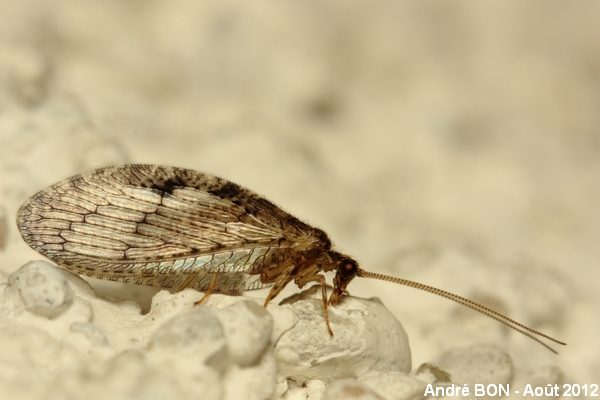
| Wesmaelius sp. (Krüger, 1922) |

|
|
Scientific name: Wesmaelius sp. (Krüger, 1922) Common name: French name: Order: Neuroptera Family: Hemerobiidae Wingspan : 20-25 mm. Biotope: Geographic area: Observation period : |
The net-winged insects show well developed wings with a dense network of veins. These wings are held roof-like over the body when at rest. The members of the Hemerobiidae family have similar shaped fore wings and hind wings (the hind wings are not enlarged at the base). The antennae are long and thread-like. The costal veinlets are ramified. I have found seven genera belonging to this family and listed as present in France: Drepanepteryx, Hemerobius, Megalomus, Micromus, Psectra, Sympherobius and Wesmaelius. The net-winged insects of the Wesmaelius genus show a recurrent veinlet (small vein at the base of the costal area on the fore wing, strongly curved towards the base), not present on the Micromus and Psectra genera. There are 4 radial veins Rs, while there are 6 or 7 on the Megalomus genus and more than 10 on the Drepanepteryx genus. (Note: You can easily tell the Drepanepteryx phalaenoides species apart with its falcate fore wings). There is a short cross vein starting from the first radial branch close to the base and connecting the branch of the median vein after the fork with the main median vein. The Hemerobius genus is missing this cross vein. Based on what I have read, the easiest criteria to differentiate net-winged insects of the Wesmaelius genus from those of the Sympherobius genus is the overall size of about 20mm compared to a maximum of 12mm. You can also use the position of the first median vein fork relatively to the origin of the first Rs branch on the hind wings but it's quite impossible to see on pictures shot in the field. |
| [To know more about the Wesmaelius sp.] [Top] |

|
The analysis of the fore wings' veins and the large size allowed me to list this net-winged insect as one member of the Wesmaelius genus. |